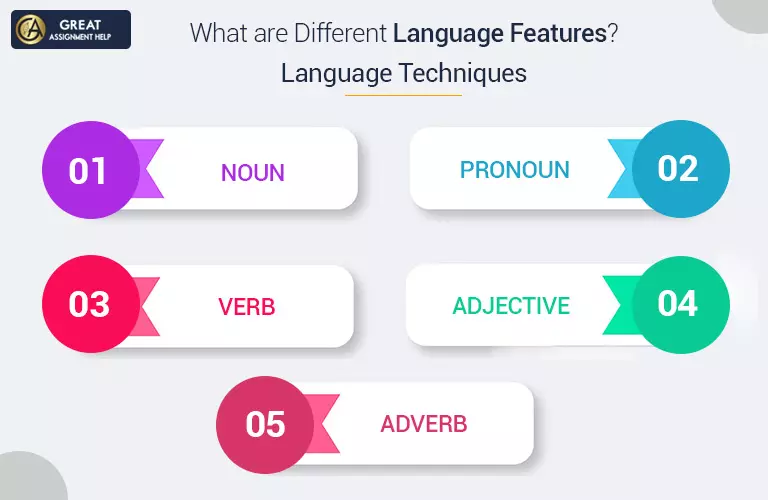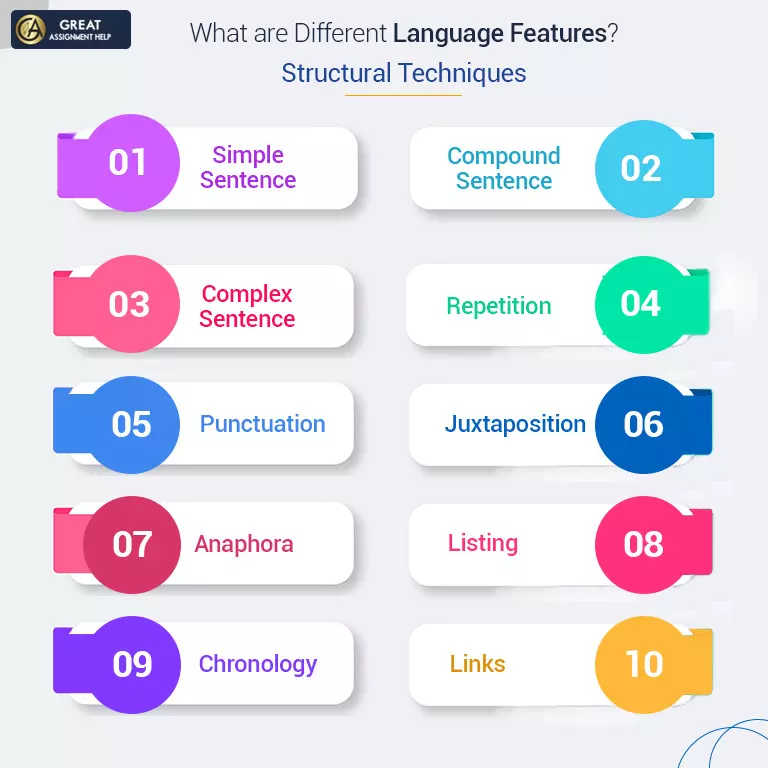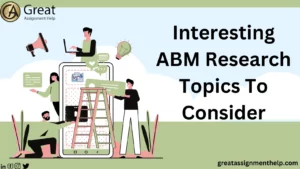What are Language Features?
English is one of the beautiful languages that have several unique attributes and special features to communicate or convey information. If you are an English literature student, then you must have a strong knowledge of language features. Remember, having a comprehension of essential literary devices and language features will be helpful for you in the creation of literary work. Moreover, you can also do a language analysis of the work created by other authors and get to know their writing approach easily. In addition to that, with the language features, you can even depict your ideas or develop different types of reports, documents, formal letter writing, and academic papers in either formal or informal manner.
If you wish to learn more about English language features, then continue reading this blog. Here, we have presented complete details about the different types of language features in English with examples.
Benefits of Using Language Features
Language is one of the practical modes of communication that has evolved. Each language comes with different styles, tones, and features. So, to have a great command over the language, while speaking and writing, one has to follow the tones, styles, and features of that particular language. Mainly, language features and methods play a vital role in building the communication skills of students. Here, let us have a look at the main purpose and the benefits of using language features in English.
- Language features help readers and listeners understand what the writer or speaker desires to convey.
- Through language features, a writer can try to persuade the minds of the readers and influence them to make certain decisions.
- The language and structural features together define the text type and shape its meaning depending on the purpose of a text, audience, and mode of communication.
- With the help of language features, a writer can describe or explain something like an incident, event, or product.
Essential English Language Features
Now, that we know what are language features, let’s explore the different types of language features in subsequent paragraphs.
Language Techniques
Specifically, language techniques imply words and phrases in content and thereby highlight its theme. Moreover, you may use language techniques in any part of your content and help the audience apprehend your work more effectively. Furthermore, if you understand language techniques well, possibly you will play smart with your content.
Meanwhile, in the English language, you may identify different language techniques and demonstrate your content in various styles and formats.
1. Noun
To illustrate, a noun is a word that identifies a name, place, animal, or thing and is categorized into different parts.
- Generally, a common noun recognizes a person or a thing. For example, man, woman, girl, and boy.
- Besides, a proper noun defines a particular noun, for example, Sunday, Lisa, and India.
- Moreover, an abstract noun identifies the attributes, conditions, and ideas that don’t exist physically. Also, you may not touch or see them. For example, happiness and friendship.
- Finally, a collective noun identifies a group of people or things, for example, players, mob, jury, and audience.
2. Pronoun
Simply, the pronoun is a word that replaces a noun or a noun phrase and helps to connect with the audience. For example, I, me, you, he, that, few, everybody, someone, whose, and whoever. “I prefer it” seems a good example of when one wants to connect to the audience.
3. Verb
Subsequently, a verb is a word that identifies an action, possibly, you may imply it in different tenses. Also, ensure to use a verb, based on the action you may perform.
Example: He walked to the theatre. Thus, walked is a verb in this sentence.
Simultaneously, the imperative is another form of the verb that provides commands, orders, and instructions. Moreover, an imperative verb is not necessarily negative, but it also includes positive orders.
4. Adjective
An adjective is a word that describes the attributes of a noun. For example, she is happy, where happy is the adjective.
Different Types of Adjectives
Comparative adjective
As the name suggests, it is used to compare two different things or people.
Examples: Taller and more costly. Robert is taller than Jack.
Superlative adjective
Similarly, a superlative adjective compares two things or people, however, it recognizes what is most superior. For example, fastest, loudest, and least valuable. Jack is the smartest member of our group.
Predicate Adjective
Subsequently, a predicate adjective is used in the predicate of the sentence in the form of a subject complement. Moreover, it follows the connecting verbs in sentences and clauses. Example: The chocolate is delicious.
Compound adjective
Meanwhile, a compound adjective is made of multiple words and is linked by a hyphen. For example, happy-go-lucky and cross-eyed. She is tired of his never-ending sorrows.
Possessive objective
Simultaneously, a possessive objective represents a possession or ownership. For example, her, his, their, your, our, and whose. My favorite drink is Coke.
Demonstrative adjective
Simply, a demonstrative adjective defines comparative positions in space and time, for example, this, that, and those. This dress is costlier than that one.
Proper Adjective
As the name suggests, a proper adjective is made of proper nouns that describe a particular place or person. For instance, I was reading a German book. Other proper adjectives include Shakespearian and Indian.
Participial Adjective
Generally, a participial adjective depends upon participles, like the words that either end with “ed” or “ing”.
For example, I am impressed by your dancing skills. Other examples, include being bored and reading.
Limiting Adjective
Mostly, a limiting adjective restricts a noun, instead of describing its attributes. For example, these, your, and some. I purchased some dresses at the shop.
Descriptive Adjective
According to its name, a descriptive adjective may describe the traits, qualities, and characteristics of a noun or pronoun. For example, he is a friendly boy.
Interrogative Adjective
As the name suggests, an interrogative adjective is used to ask questions, for example, what, whose, and which. Which is your favorite book?
Distributive Adjective
Lastly, a distributive adjective is used to identify members of a team personally. For example, neither, either, every. Each student in the class scored well.
5. Adverb
Simply, an adverb is another language feature that modifies the meaning of a verb, adjective, or adverb. Let’s explore how.
| Verb | She dances gracefully. |
| Adjective | He is amazing. |
| Adverb | She strolls cautiously. |
Now let’s explore a few more adverbs that seem important for you to understand the language techniques.
- Abruptly
- Financially
- Willfully
- Delightfully
- Quickly
- Lightly
- Firmly
- Eternally
- Truthfully
- Sorrowfully
- Delicately
- Beautifully
- Wearily
Below, you may find a list of a few more words that showcase how a thing was executed:
- Weirdly
- Brutally
- Really
- Randomly
- Wickedly
- Sloppily
- Briskly
- Uneasily
- Expertly
- Cheerfully
Below, you will identify more words that might reveal where the move has established a place.
- Upstairs
- Downstairs
- Everywhere
- Out
- Inside
- In
- Somewhere
- Here
- There
- Underground
Now let’s explore a few more adverbs that might tell us when a move has established a place.
- First
- Last
- Early
- Today
- Tomorrow
- Yesterday
- Often
- Never
- Regularly
- Monthly
- Always
- Usually
Again, you may find below the last set of adverbs that might define the degree of specific activities taking place.
- Too
- Almost
- Very
- Also
- Enough
- So
- Quiet
- Rather
- Almost
Structural Techniques
If you have reached here, perhaps you have some difficulties in understanding structural techniques. Generally, in any language, structural highlights play a vital role in explaining the structure of a language. Moreover, a language might lose its importance, if it is not formatted correctly. Also, a simple sentence might appear vague if it doesn’t have a formal structure. In a nutshell, a structural technique defines the order of ideas in a specific text.
For example, if you need to write a story, possibly you will structure your ideas and add meaning to them. Also, when you write simple sentences or novels, structural techniques seem important to add relevance to the respective languages.
Let’s explore a few popular structural techniques and their role in adding value to a language:
1. Simple Sentence
Usually, a simple sentence comprises a single clause, a subject as well as a verb. Moreover, a simple sentence is concise as well as short and it is a famous technique that easily drives the reader’s interest.
Example: The bus was late.
2. Compound Sentence
Mostly, a compound sentence comprises two independent clauses that are combined using a conjunction. Also, it is the most significant language structure that integrates two different ideas.
Example: I like coffee and my brother likes tea.
3. Complex Sentence
Meanwhile, a complex consists of one or even multiple subordinate clauses.
Example: He returned her laptop after he noticed it was broken.
4. Repetition
As the name suggests, repetition implies using a phrase or a word multiple times.
Example: Hand in Hand.
5. Punctuation
Generally, punctuation is used to explain the meanings of various texts. Mostly, it clarifies the significance of the text by separating phrases, words, links, or clauses. For instance, question marks, period, colon, semi-colon, exclamatory, and brackets.
Example: “Yes, Sir, I went for a walk.”
6. Juxtaposition
Mostly, in a juxtaposition, a minimum of two ideas, places, characters, and their functions are positioned next to each other. Also, a juxtaposition exists in a sonnet or a narrative for developing complexities and examinations. Moreover, the authors make use of an artistic process to surprise their readers and influence their benefits. Generally, the writers establish a correlation between two disparate things by positioning them next to each other. Furthermore, when you examine it, it might add significant quality to a particular image and regulate the pacing of a sonnet. In short, it creates a logical connection between two different unclear ideas.
Example: Beggars can’t be choosers.
So, if you notice in the above sentence both beg and choose are contrasting activities. Furthermore, the sentence implies that a person may not act disparate as well as choose at the same time.
7. Anaphora
If you notice the iteration of a word at the start of consecutive clauses, certainly it’s called an anaphora. Mostly, an author might apply anaphora while he is writing or even in discourse. Moreover, in an anaphora, the authors purposefully rehash the basic segment to create an artistic impact.
Example: If my son moves to London, I will be there too.
8. Listing
Simply, the listing is the technique of writing several linked items one after the other to specify their quality. For instance, a listing seems appropriate in the case of writing an essay and a research paper. In brief, a listing is mostly used when the author wants to make a point familiar to the audience.
9. Chronology
The arrangement of events in the order of time is known as chronology. Moreover, in literature, the authors apply chronology to tell the events happening in a specific story. Meanwhile, it seems simple for the readers to apprehend the events if it’s written in chronological order. For example, an event may adopt different arrangements, like reverse, linear, and non-linear approaches.
10. Links
Lastly, the link is a structural technique, which connects the beginning and the end of a text during a narration. Mostly, in the case of a natural narration, links play a vital role.
Emotional Language
Simply, it’s a language that is recommended to create an avid reaction, among the readers of stories or poems. Perhaps, if a sentence is presented normally, it will not create any impact on the audience. However, if emotive language is added to the same sentence, possibly it will create a different reaction among the audience.
Examples:
- “Put the books inside the locker.”
Perhaps, this sentence has adopted a commanding style.
- “You should put the books inside the locker because it will be safe”.
This sentence makes a suggestion as well as creates an emotional response for the audience.
Thus, when emotive language is used effectively, it might create an important impact on the audience. However, don’t overuse emotive language in sentences, instead, use it when you genuinely need it.
Literary Devices
Mostly, a literary device is used by poets as well as literature writers to communicate their ideas or messages. Possibly, if know literary devices, you will interpret what an author is trying to communicate.
Major Literary Techniques
Generally, a literary technique is a figurative language that is applied by the writers for narration to choose the literary research topics. Let’s explore below some important literary techniques.
Allusion
Mostly, it indirectly gives reference to an individual, place, or thing. Moreover, it depicts thoughts of political significance or that which is social, historical, or abstract. However, an allusion doesn’t comprehensively depict a person, place, or thing, instead, it only remarks. Furthermore, a writer might anticipate that the audience needs sufficient details to identify an allusion. Additionally, the readers also need to manage the significance of the book.
Allegory
Generally, an allegory is an interesting expression through which a writer may advance their political and good perspectives. In a nutshell, the key goal of an allegory is to teach an ethical exercise.
Assonance
Usually, the iteration of vowel sounds that develops an internal rhyming in between phrases and sentences is called assonance. Meanwhile, the writers use assonance to add literary value to their work and drive the reader’s interest.
Imagery
The imagery writers make use of vibrant language to communicate objects, thoughts, and activities. Also, it generates a lively and graphical introduction of an image that drives the interest of a prudent audience.
Simile
Perhaps, it compares two different objects through words like as or like. Generally, a simile is used by poets, when they want to make their descriptions clear.
Metaphor
It’s a word or phrase that unrealistically explains something.
Hyperbole
Simply, hyperbole is an exaggerated statement that is not taken literally by the readers. Frequently, it is used to create an emphasis on the minds of the readers.
Personification
In a nutshell, personification compares a non-living thing to a person.
Irony
Generally, it is a statement that depicts an opposite meaning rather than a literal meaning.
Oxymoron
Mostly, the oxymoron joints at least two contrasting terms.
Symbolism
Simultaneously, symbolism makes use of images to indicate thoughts and perspectives.
Zoomorphism
It involves assigning an occasion, individual, or divinity with carnal attributes.
Basic Literary Elements
Generally, a literary piece makes use of the following literary elements:
- Theme- Key concept or perspective of the story.
- Plot- The sequential order of events that develops into a story.
- Conflict- The issue in the story. Perhaps the story revolves around an issue.
- Protagonist- The main character in the story.
How Language Features Will Be Helpful to You?
Do you believe that only English language and literature students should study language features? It is a misunderstanding that you should instantly dispel.
- The aforementioned examples demonstrate how language features are used in our daily lives. Therefore, having a firm knowledge of them boosts your confidence and communication abilities.
- Information and concepts can be efficiently conveyed through language features. For instance, you can explain your ideas to a reader or an audience and help them comprehend the data or your opinions.
- Once grasped, language features are a great help to you. When it comes to producing well-written speeches, novels, poetry, and other written texts, they are your dependable allies. Your writing grows convincing, your expressions get more sophisticated, and your observation and writing skills sharpen as a result.
Conclusion
Hopefully, by now, you will have gained a better understanding of what English language features are. But, to make your literary assignments stand unique in the crowd, make sure to use the appropriate language features or techniques. In case, you still have any doubts about it, contact the experts on our platform. They will solve all the queries related to language strategies and provide the best guidance as per your requirements. Moreover, with the support of the subject professionals from our team, you can also come up with an outstanding academic paper by including the essential language features and literary elements. Just book your order on our website to complete your literature assignments on time.





